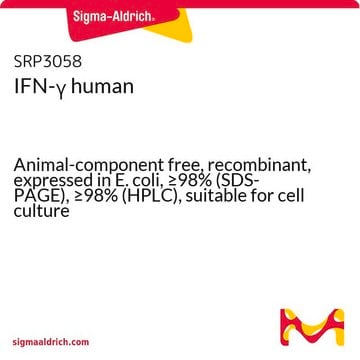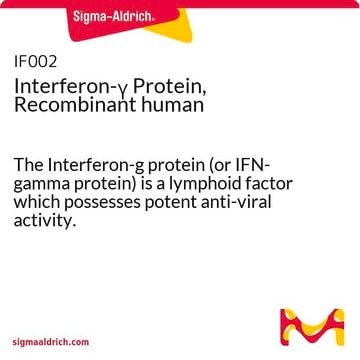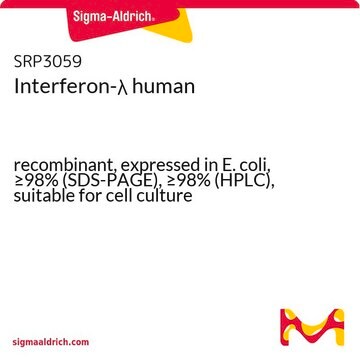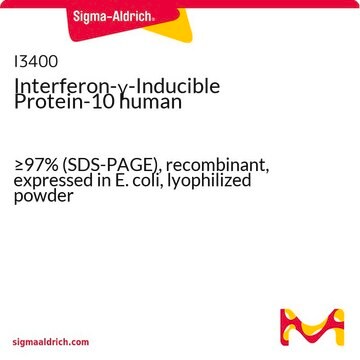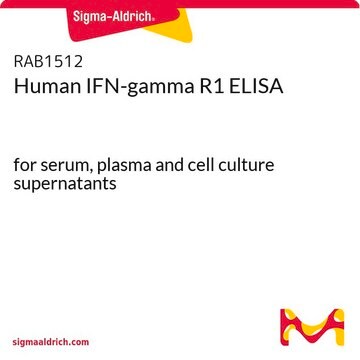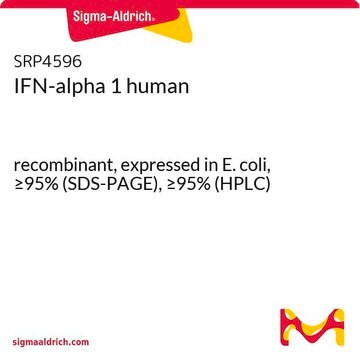General description
IFN-γ is produced by T-lymphocytes stimulated by antigen or by T-cell mitogens. Under nondenaturating conditions its molecular weight values range from 32,000 to 73,000 indicating that recombinant human IFN-γ exists as a dimer or higher oligomers.
Specificity
Human IFN-γ is effective on human cells, but not on mouse or rat cells.
Application
Interferon-γ, human (hIFN-γ) has been used to stimulate mesenchymal stem cells (MSCs). It has also been used as a supplement Dulbecco′s modified Eagle′s medium/Ham′s medium for the cultivation of human colorectal carcinoma cell line T84 cells.
Interferon-γ, human (hIFN-γ), can be used to investigate IFN-γ activities in human cell systems.
Biochem/physiol Actions
A broad range of biological activities has been attributed to IFN-γ (e.g., the establishment of the antiviral state, immunoregulatory functions, antiproliferative effects and inhibition of cell growth). The anti-proliferative effects of IFN-γ are superior to those of either IFN-α or IFN-β. Growth inhibition is dependent on cell type, dose, and length of exposure. One of IFN-γ′s primary functions might be as an immunoregulatory agent: IFN-γ induces MHC antigens on many cells, Fc-receptors on monocytes and macrophages, IL-2 receptors on T-cells, enhances activity of macrophages, polymorphonuclear leukocytes, T-lymphocytes, and NK-cells (MAF), and is also involved in the regulation of B-cells.
Interferon-γ (IFN-γ) is an essential component of acquired immunity. A broad range of biological activities has been attributed to IFN-γ (e.g., the establishment of the antiviral state, immunoregulatory functions, antiproliferative effects and inhibition of cell growth). The anti-proliferative effects of IFN-γ are superior to those of either IFN-α or IFN-β. Growth inhibition is dependent on cell type, dose, and length of exposure. One of IFN-γ′s primary functions might be as an immunoregulatory agent: IFN-γ induces MHC antigens on many cells, Fc-receptors on monocytes and macrophages, IL-2 receptors on T-cells, enhances activity of macrophages, polymorphonuclear leukocytes, T-lymphocytes, and NK-cells (MAF), and is also involved in the regulation of B-cells.
Quality
The raw material used for this preparation was tested for HBs antigen and for the presence of antibodies to HIV-1, HIV-2, and HCV found to be negative.
Endotoxin level: <0.1EU/μg (LAL-test), <10EU/ml (LAL-test)
Note: 1EU corresponds to 0.1ng
Sequence
Chain Length 143 AA
The primary structure of recombinant human IFN-γ (143 amino acids) is identical to that of natural human IFN-γ (146 amino acids), however, recombinant IFN-γ has three amino acids less and is not glycosylated. Glycosylation is not essential for biological activity.
Unit Definition
EC50 definition: The amount of hIFN-γ that is required to produce equivalent antiviral activity to that expressed by 1 unit of the NIH IFN-γ reference standard (Gg 23– 901-530) (WISH cells-EMC virus/cytopathic effect) (1 unit equals ≤0.05 ng/ml).
Physical form
100,000U/ml or 1,000,000U/ml of Human IFN-γ in 0.1M phosphate buffer saline (PBS) (pH 7.0), 2.5% sucrose (w/v), and 2.5% human serum albumin (HSA) (w/v), filtered through a 0.2μm pore size membrane.
Preparation Note
Working solution: Solvent is recommended in double-distilled water.
Storage conditions (working solution): Stability in culture: Activity is present for at least 18 hours in culture medium.
Other Notes
EC 50 : <0.05ng/ml (hIFN-γ , NIH, reference standard, Gg 23–901-530)
For life science research only. Not for use in diagnostic procedures.

